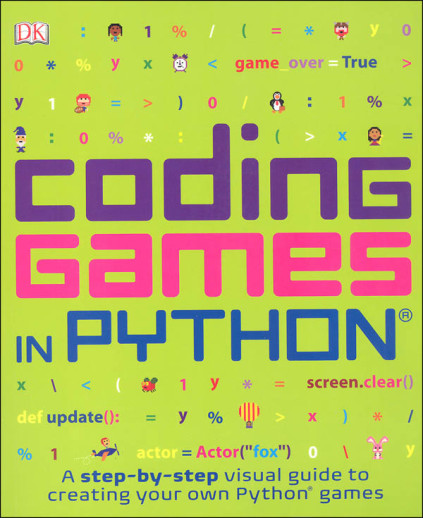We use cookies to make your experience better. To comply with the new e-Privacy directive, we need to ask for your consent to set the cookies. Learn more.
Coding Games in Python
Covers introductory Python programming and basic game functions through 9 full Python game projects. 224 pages, pb.
A visual step-by-step guide to writing code in Python.
Beginners and experienced programmers can use Python to build and play computer games, from mind-bending brainteasers to crazy action games with explosive sound effects and 3-D graphics.
Each chapter in Coding Games in Python shows how to construct a complete working game in simple numbered steps. The book teaches how to use freely available resources, such as PyGame Zero and Blender, to add animations, music, scrolling backgrounds, 3-D scenery, and other pieces of professional wizardry to games. After building a game, instructions show how to adapt it using secret hacks and cheat codes. Instructions are illustrated with zany Minecraft-style pixel art.
Master the key concepts that programmers need to write codenot just in Python, but in all programming languages. Find out what bugs, loops, flags, strings, tuples, toggles, and turtles are. Learn how to plan and design the ultimate gameand then play it to destruction as you test and debug it.
With coding theory interwoven into the instructions for building each game, learning coding is made effortless and fun.
Labeled as Step-by-step visual guides to coding, these DK guides are certainly the friendliest introductions to programming Ive seen! Designed for younger students new to coding, these books serve as introductory-level guides for both programming in general as well as Scratch and Python. A brief introduction to the language and topic sets the stage before students embark upon projects of gradually-increasing complexity. Relevant illustrations (helpful and humorous!), line each and every page, accentuating the given topic and adding a touch of fun to keep kids engaged. Text is divided into simple bullet paragraphs which play off the provided drawings perfectly. Once actual projects come into play, these paragraphs are numbered and illustrated with screenshots to mimic what the student will be seeing on the screen. Captions, arrows, and other guides provide further aid during crucial steps.
In addition to these simple nuances, the material within each book is more than adequate for introductory coding. A rather lengthy Getting Started/First Steps chapter in each book provides basic tools and an intro to the language within the context of simple programs. Students are briefly introduced to a concept or function, and then they follow along in creating a program that uses that concept or function. Once its created, students are usually asked to modify it to add greater functionality rather than write a new program. Finally, students apply the knowledge theyve gained to create cohesive games and projects. Its a wonderfully seamless system, and certainly one I wish I had in my early coding books!
| Product Format: | Paperback |
|---|---|
| Brand: | Dorling Kindersley |
| Grades: | 3-7 |
| ISBN: | 9781465473615 |
| Length in Inches: | 9.25 |
| Width in Inches: | 7.75 |
| Height in Inches: | 0.5 |
| Weight in Pounds: | 1.5 |

